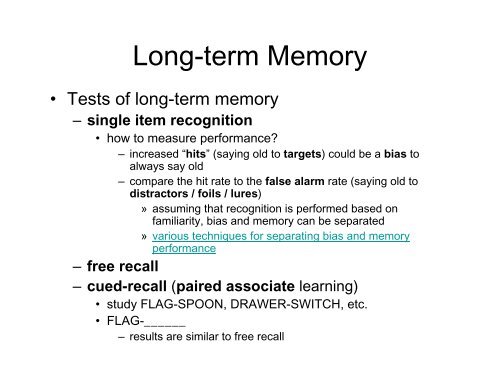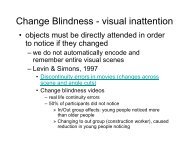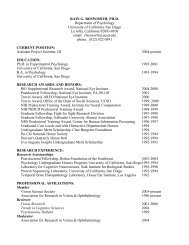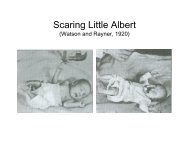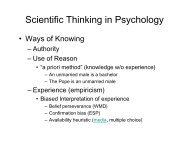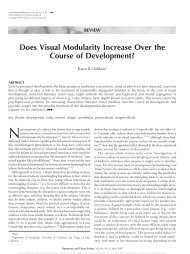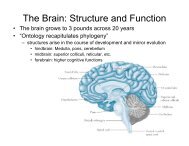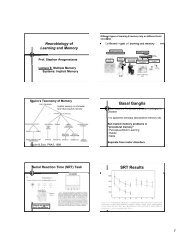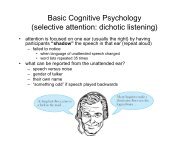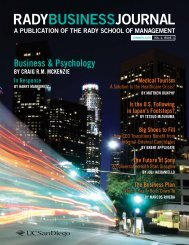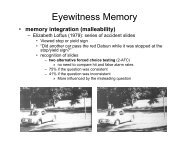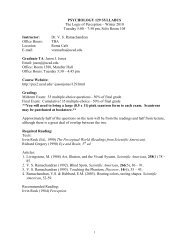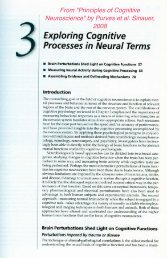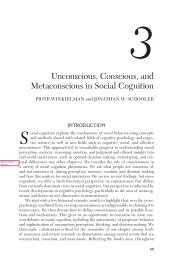Long-term Memory
Long-term Memory
Long-term Memory
You also want an ePaper? Increase the reach of your titles
YUMPU automatically turns print PDFs into web optimized ePapers that Google loves.
<strong>Long</strong>-<strong>term</strong> <strong>Memory</strong><br />
• Tests of long-<strong>term</strong> memory<br />
– single item recognition<br />
• how to measure performance?<br />
– increased “hits” (saying old to targets) could be a bias to<br />
always say old<br />
– compare the hit rate to the false alarm rate (saying old to<br />
distractors / foils / lures)<br />
» assuming that recognition is performed based on<br />
familiarity, bias and memory can be separated<br />
» various techniques for separating bias and memory<br />
performance<br />
– free recall<br />
– cued-recall (paired associate learning)<br />
• study FLAG-SPOON, DRAWER-SWITCH, etc.<br />
• FLAG-______<br />
– results are similar to free recall
Theories<br />
• levels of processing: the only difference between STM<br />
and LTM is whether encoding is “shallow” or “deep”<br />
– memory is a continuum; not different components<br />
– deep processing is more semantic and self-referential and<br />
results in stronger, longer lasting memories<br />
– shallow processing is concerned with physical characteristics<br />
and results in weaker, temporary memories<br />
– Craik and Tulving (1975) had participants study adjectives with<br />
the following four tasks (listed from worst to best memory)<br />
• Is it in upper case?<br />
• Does it rhyme with ?<br />
• Does it fit in the sentence ?
• Modal view of memory (qualitative differences<br />
between STM and LTM)<br />
– Capacity<br />
• STM around 7 chunks, LTM nearly unlimited<br />
– Duration<br />
• STM around 30 seconds, LTM can last a lifetime<br />
–Coding<br />
• STM is acoustic<br />
– confuse “b” and “g”<br />
• LTM is semantic<br />
– Baddeley (1966a) – 20 minutes after studying a list<br />
» poor recall for semantically similar lists (HUGE, BIG, SIZE,<br />
etc.)<br />
» normal recall from acoustically similar lists (MAD, MAP,<br />
MAN, etc.)
Forgetting: Storage versus Retrieval<br />
• interference at retrieval<br />
– memory is like a cluttered desk<br />
– all memory traces are preserved in LTM, but it’s hard<br />
to retrieve them<br />
• can’t find the right retrieval cues<br />
– if all traces compete<br />
• both proactive and retroactive interference
• interference at storage (neural networks)<br />
– memory is like many pictures drawn on top of each<br />
other so its hard to see any individual picture<br />
– when memories are added, the representation is<br />
permanently changed<br />
• new memories overwrite old memories (retroactive<br />
interference)<br />
• old memories make it more difficult to encode new memories<br />
(proactive interference)<br />
– an example – adding memories to a Hopfield network<br />
• when memories are stored, links between the features of a<br />
memory are created<br />
• at retrieval, activated features serve as the retrieval cues and<br />
the system cycles until the activation no longer changes
Nurse<br />
Sick<br />
Study List<br />
Lawyer<br />
Medicine<br />
Health<br />
Hospital<br />
Dentist<br />
Physician<br />
cure<br />
Patient<br />
Office<br />
Surgeon<br />
Bed<br />
Rest<br />
Awake<br />
Tired<br />
Dream<br />
Snooze<br />
Blanket<br />
Doze<br />
Slumber<br />
Snore<br />
Nap<br />
Yawn
Results<br />
• Forgetting Curves<br />
– Ebbinghaus’s (1885) nonsense syllable experiment<br />
• over the course of days, he kept on relearning lists of nonsense<br />
syllables (e.g., RUR, HAL, BEIS, etc.)<br />
• forgetting was measured as percent savings (a comparison of<br />
immediate testing versus testing after a delay)<br />
• information is rapidly forgotten at first (non-linear)
• Bahrick’s (1983) Delaware, Ohio experiment<br />
– real-life demonstration of forgetting curves<br />
– students and alumni of Ohio Wesleyan were asked<br />
• free recall of streets, buildings, and landmarks<br />
• using a map, write in street names, buildings, and landmarks<br />
(visually cued)<br />
• recognition of streets, buildings, and landmarks (matching)<br />
– current students who had been there different<br />
amounts of time provided learning curves<br />
• buildings and landmarks learned faster<br />
– alumni of different ages provided forgetting curves<br />
• buildings and landmarks forgotten more slowly
Test List<br />
Lawyer<br />
Doctor<br />
Rest<br />
Sleep
• false memory<br />
effect (DRM)<br />
– higher false alarm<br />
rate for critical<br />
lures (sleep)<br />
Test List<br />
Lawyer<br />
Doctor<br />
Rest<br />
Sleep<br />
Nurse<br />
Sick<br />
Lawyer<br />
Medicine<br />
Health<br />
Hospital<br />
Dentist<br />
Physician<br />
cure<br />
Patient<br />
Office<br />
Surgeon<br />
Bed<br />
Rest<br />
Awake<br />
Tired<br />
Dream<br />
Snooze<br />
Blanket<br />
Doze<br />
Slumber<br />
Snore<br />
Nap<br />
Yawn
• memory is worse when similar items are studied<br />
– A,B,C, vs. A,A’,A’’ (false memory effect)<br />
• memory is better when context is kept the same<br />
– encoding specificity<br />
• study “spelling-BEE” or “honey-BEE” – cue as context<br />
• Golden and Baddeley (1975) – environmental context<br />
– words learned on land or underwater<br />
– Words tested on land or underwater<br />
memory<br />
performance<br />
LTM Effects<br />
study<br />
on land<br />
study<br />
underwater<br />
test<br />
underwater<br />
test<br />
on land
– state-dependent learning<br />
• same design as scuba experiment but using<br />
pharmacological states as a context (Eich, 1980)<br />
memory<br />
performance<br />
study<br />
drunk<br />
study<br />
sober<br />
test<br />
sober<br />
test<br />
drunk
• memory for longer lists is worse (length effect)<br />
– A,B,C vs. A,B,C,D,E,F<br />
• memory is better when stimuli are studied longer<br />
(strength effect)<br />
– A,B,C vs. A,A,A,B,B,B,C,C,C<br />
– distributed study is better than massed study (i.e., cramming)<br />
• spacing effect<br />
– A,A,A,B,B,B,C,C,C vs. C,A,BA,B,C,B,A,C<br />
– Encoding variability<br />
» More cues (many hooks one memory)<br />
» Cue overload (one hook many memories)<br />
• differences between recognition and recall<br />
– low frequency (obscure) items are recognized better but harder<br />
to recall<br />
– high frequency (common) items are harder to recognized but<br />
easier to recall
Narrative and Autobiographical <strong>Memory</strong><br />
• Do laboratory studies of memory apply to real life<br />
memory for stories and personal events?<br />
– Bartlett (1932) thought memory is often reconstructed based on<br />
schemata (constructive view of LTM).<br />
• serial reproduction: recall the same story on more than once<br />
– “War of the Ghosts” became more distorted with each reproduction<br />
– Autobiographical memory for ordinary events<br />
• Marjorie Linton (1975, 1982) spent six years recording the daily<br />
events in her life in a systematic fashion
• each day short descriptions of events<br />
– the date, how distinctive, how emotional, importance to<br />
life goals<br />
• tested herself at delays up to three years<br />
– order two events (which happened first)<br />
– provide exact dates of events<br />
• performance was good at all delays<br />
– real life memories are more durable<br />
» testing is similar to recognition and cued-recall<br />
– she often used problem solving to arrive at the dates of<br />
events<br />
» constructivist view of memory<br />
• events that she could not recall where often similar<br />
to other events she could not recall<br />
– repeated similar events can start to form a schema
– Barsalou (1988) interviewed undergrads for specific<br />
autobiographical events from the summer<br />
• only 21% of recollections were specific<br />
• the rest were “summarized events” (e.g., “I went to the beach<br />
everyday”)<br />
– Brewer (1988) used beepers to test randomly<br />
selected events<br />
• Linton studied the most important events of the day instead<br />
of the ability to recollect any particular event within the day<br />
• at random times (~2 hours), participants were alerted by a<br />
beeper and would write down:<br />
– location, time, actions, and thoughts<br />
– also a number of ratings<br />
» how often this event occurred<br />
» how pleasant<br />
» how trivial or significant<br />
– he also had them write down the most memorable event of<br />
each day
– memory was pretty good overall<br />
» did not fall off rapidly like Ebbinghaus’ studies<br />
– memory was better for actions than for thoughts<br />
– better for the most memorable events of the day<br />
– better for infrequent events and locations<br />
– better memory for rare actions<br />
» the more distinctive the event, the better the memory<br />
for that event
Flashbulb Memories<br />
(Brown & Kulik, 1977)<br />
• personal events at time of disaster<br />
– JFK assassination, Challenger explosion, start of gulf<br />
war, 9/11, etc.<br />
• physiological response<br />
– emotional responses cause hormone release<br />
• better encoding<br />
– Study of Ronald Reagan assassination attempt<br />
• stronger emotional responses = more details
• Neisser (1982b)<br />
– link to history<br />
• Story retelling<br />
– memory strengthening (rehearsal)<br />
– progressive distortion<br />
• Bonhannon’s (1988)<br />
– Challenger explosion<br />
• stronger emotions = greater memory<br />
• more retellings = greater memory<br />
• Weaver (1993) compared intentional memory to<br />
flashbulb memory<br />
– remember next meeting with roommate<br />
• Immediately, 3 months, 1 year<br />
– gulf war started at same time (direct comparison)<br />
• No accuracy differences<br />
– Ebbinghaus forgetting<br />
• Higher confidence for flashbulb<br />
– No relationship between accuracy and confidence
Eyewitness <strong>Memory</strong><br />
• memory integration (malleability)<br />
– Elizabeth Loftus (1979): series of accident slides<br />
• Viewed stop or yield sign<br />
• “Did another car pass the red Datsun while it was stopped at the<br />
stop/yield sign?”<br />
• recognition of slides<br />
– two alternative forced choice testing (2-AFC)<br />
» no need to compare hit and false alarm rates<br />
– 75% if the question was consistent<br />
– 41% if the question was inconsistent<br />
» More influenced by the misleading question
– Loftus (1975) had people view a film (no barn)<br />
• “How fast was the white sports car going when it passed the<br />
barn while traveling along the country road?”<br />
– One week later<br />
» Barn in sentence: 17% reported barn<br />
» No barn in sentence: 3% reported barn<br />
– Bransford and Franks (1971) had people read simple<br />
sentences such as:<br />
• The ants were in the kitchen<br />
• The jelly was on the table<br />
• The jelly was sweet<br />
• The ants ate the jelly<br />
• On a later test, they recognized with highest confidence the<br />
unseen combined sentence:<br />
– The ants in the kitchen ate the sweet jelly that was on the table
• does eyewitness confidence indicate accuracy?<br />
– courts place importance on confident eyewitness testimony<br />
– 36 of 40 DNA overturns were convictions on eyewitness<br />
identification<br />
• what’s the best way to conduct a lineup?<br />
– maximize identification of guilty suspects<br />
• similar to increasing the hit rate<br />
– minimize identification of innocent suspects<br />
• similar to decreasing the false alarm rate<br />
• lineup as a psychology memory experiment<br />
– same concerns<br />
• demand characteristics, bias to say ‘old’, etc.
• selecting distractors in a lineup (known-innocents)<br />
– nominal size: # in the lineup<br />
– functional size: # fit the suspect’s description<br />
– the use of mock eyewitnesses<br />
• if they prefer the suspect, the lineup is flawed<br />
– match-to-description, or also resemble-suspect?<br />
• either way, innocent suspect is protected against erroneous identification<br />
• if the distractors resemble-suspect, identification of guilty suspect is lower<br />
• demand characteristics<br />
– subtle cues<br />
– exert pressure to select (relative judgment)<br />
– double-blind eliminates these concerns<br />
• Not adopted by law enforcement<br />
• relative judgments versus absolute identification<br />
– more likely to convict innocent suspects w/ relative judgments<br />
– “none of the above”<br />
– sequential lineup<br />
• reduces ID of innocent suspects<br />
• doesn’t reduce ID of guilty suspects<br />
• however, might enhance demand characteristics
– is confidence related to accuracy?<br />
• weakly in real life<br />
– meta-analysis: 6% of the variance<br />
• reliable in in the laboratory<br />
– within-subjects correlation<br />
– between-subjects differences are larger<br />
• lineups: 1 observation per subject<br />
– can’t assess type of person<br />
• selection factor<br />
– people who actually select, likely to have high confidence<br />
• in summary<br />
– Confidence: social and personality factors<br />
» positive feedback from investigators<br />
– Accuracy: perceptual and memorial factors
False <strong>Memory</strong><br />
• “psychological problems indicate abuse or<br />
trauma as a child”<br />
– the self-help book, “The Courage to Heal”<br />
• “if you have a pattern of symptoms such as low self-esteem,<br />
depression, etc., then you were probably abused”<br />
– Court cases of recovered abuse<br />
– often memories arise in therapy<br />
• questionable therapy as source<br />
– hypnosis<br />
– sodium amytal<br />
– leading questions<br />
– imagination exercises
– Implanting new memories<br />
• Loftus and Pickrell (1995): 3 true events and one<br />
false “lost-in-the-mall”<br />
– interviews of relatives<br />
– between 4 and 6 years old at time of event<br />
– Booklet: description of the events<br />
» Fill in remembered details<br />
– remembered<br />
» 68% of the true events<br />
» 29% of false events<br />
– still recalled 1 and 2 weeks later<br />
– Differences<br />
» more words used to describe true memories<br />
» true memories rated as being more clear
• Hyman, Husband, and Billings (1995)<br />
– hospitalization, birthday/clown, wedding/punch, evacuate/store<br />
» 80-90% of true events<br />
» no false events recalled in first interview<br />
» 20% in a second interview<br />
» some participants elaborated upon their false memories<br />
(added details never presented)
• Forms of suggestion<br />
– Interviewing suspected criminals<br />
• imagine they participated in a crime<br />
– Therapists<br />
• imagine childhood events to recover them<br />
• self-help books: exercises<br />
– where would the abuse have been likely to occur?<br />
– who is the likely perpetrator?<br />
• Childhood Sexual Abuse (CSA)<br />
– Clancy et al. (2000) used DRM paradigm<br />
• Control group<br />
• Continuous memory of CSA<br />
• “repressed memory” of CSA<br />
• “recovered memory” of CSA<br />
– Recovered group showed much higher false DRM recall
• Loftus – imagination inflation<br />
– Likely to have occurred<br />
– imagination<br />
– Give likelihood ratings again<br />
– increased for imagined<br />
• imagination makes more familiar<br />
• familiarity is misattributed to<br />
childhood<br />
– source confusion
• Impossible memories (first year)<br />
– hippocampus and frontal lobes are underdeveloped<br />
– implanting impossible memories<br />
• good eye coordination comes from mobile<br />
• hypnotized and age regressed<br />
• “guided mnemonic restructuring”<br />
– imagination<br />
• false memory for<br />
– 46% of the hypnotic participants<br />
– 56% of the guided participants
• need experience/knowledge/script Pedzek et al.<br />
(1997)<br />
– Catholic and Jewish participants<br />
» 3 true memories<br />
» 1 false Shabbat and communion<br />
– no give-away words<br />
– 29 Catholic participants<br />
» 7 falsely recognized the Catholic event<br />
» 1 falsely recognized the Jewish event<br />
– 32 Jewish participants<br />
» 3 falsely recognized the Jewish event<br />
» 0 falsely recognized the Catholic event<br />
All these results only mean that recovered<br />
memories might be false
edspread<br />
betrayal<br />
donate<br />
escapade<br />
holly<br />
iceberg<br />
missile<br />
numeral<br />
outcast<br />
painless<br />
plumber<br />
plural<br />
priority<br />
rancher<br />
reversal<br />
skeleton<br />
trigger<br />
trinket<br />
waffle
Amnesia
• Bilateral damage to the medial temporal lobes<br />
– Hippocampus<br />
• memory for events and episodes<br />
– Amygdala<br />
• memory for emotions<br />
– patient H.M. (1953)<br />
– sources of damage<br />
• Surgery, stroke, hypoxia, head injury<br />
• Korsakoff’s syndrome, Alzheimer’s disease<br />
• electroconvulsive therapy (ECT), benzodiazepines<br />
– anterograde and retrograde amnesia<br />
brain<br />
damage<br />
PAST PRESENT<br />
retrograde<br />
anterograde
• Anterograde amnesia<br />
– Inability to form new long-<strong>term</strong> memories<br />
• general knowledge and personal history are frozen<br />
– recall, recognition, etc.<br />
– new vocabulary (e.g. jacuzzi, granola, etc.)<br />
• intact STM<br />
• all modalities are affected<br />
• Skill learning<br />
– Implicit learning, but no explicit memory (ch. 6 235-238)<br />
» procedural versus declarative<br />
– motoric or perceptual (i.e., cannot learn chess)<br />
» rotary pursuit<br />
» mirror tracing<br />
» mirror image reading<br />
» new words (not meaning)<br />
» long-<strong>term</strong> priming (stem and fragment completion)
ed__<br />
bet__<br />
don__<br />
esc___<br />
hol___<br />
ice___<br />
miss___<br />
num___<br />
out___<br />
pain___<br />
pl_m__r<br />
p_ur_l<br />
pr_o_ity<br />
ra_c_er<br />
re_e_sal<br />
s_el_ton<br />
t_ig_er<br />
t_in_et<br />
w_f_le
• Retrograde amnesia<br />
– loss of old memories<br />
• some retrograde amnesia is associated with<br />
anterograde amnesia<br />
– the time period just before the injury is forgotten<br />
(temporally graded)<br />
– depends upon abruptness<br />
• Korsakoff’s and Alzheimer’s<br />
–memory consolidation (Squire)<br />
• Hippocampally dependent<br />
– Memories are distributed throughout the cortex<br />
– Hippocampus ties together the various components<br />
– with time, the cortex can learn to do this on its own<br />
– this process is called memory consolidation<br />
• forgetting curves and amnesia
Improving <strong>Memory</strong> (ch. 8, 274-277)<br />
• Terms<br />
– Mnemosyne: Greek goddess<br />
– Mnemonic: memory aid<br />
– Mnemonist: skilled memory<br />
• variables that strengthen LTM<br />
– the spacing effect<br />
• encoding specificity<br />
• state-dependent learning<br />
– semantic encoding (a.k.a. deep encoding)<br />
• self-referential works best<br />
– rare or unusual<br />
• violate the schema<br />
– strong emotions (flashbulb memories)<br />
• physiological arousal<br />
– visual imagery
• Mnemonic Techniques<br />
– relate new to old information<br />
• chunking<br />
– N F L C B S I R A M T V<br />
• the method of loci<br />
– ordered landmarks and imagery
• technique of interacting images<br />
– in paired-associate learning (e.g., goat-pipe, tablehorse,...),<br />
forming a joint image<br />
• the pegword method<br />
– one is a bun<br />
– two is a shoe<br />
– three is a tree<br />
– four is a door<br />
– ....<br />
• recoding of material (similar to chunking)<br />
– HOMES = Huron, Ontario, Michigan, Erie, Superior


